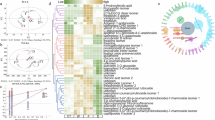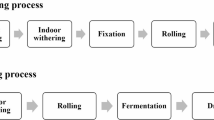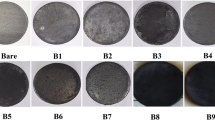Abstract
PAPER chromatography has revealed the presence in tea-leaf of a large number of substances giving a yellow colour on the chromatogram on exposure to ammonia vapour. These are regarded as anthoxanthins, and two of them have been identified as rutin and quercitrin1. Chromatograms of fermented tea show the same pattern of anthoxanthin spots, which suggests that these substances are not oxidized enzymically by the tea-oxidase, although some of them presumably contain catechol or pyrogallol groupings in their molecules.
This is a preview of subscription content, access via your institution
Access options
Subscribe to this journal
Receive 51 print issues and online access
$199.00 per year
only $3.90 per issue
Buy this article
- Purchase on SpringerLink
- Instant access to full article PDF
Prices may be subject to local taxes which are calculated during checkout
Similar content being viewed by others
References
Roberts, E. A. H., and Wood, D. J. (results submitted to Biochem. J.).
Roberts, E. A. H., and Wood, D. J., Biochem. J., 47, 175 (1950).
Author information
Authors and Affiliations
Rights and permissions
About this article
Cite this article
ROBERTS, E., WOOD, D. Oxidation of Anthoxanthins by Tea-Oxidase. Nature 167, 608 (1951). https://doi.org/10.1038/167608a0
Issue date:
DOI: https://doi.org/10.1038/167608a0
This article is cited by
-
Effect of Glycosylation on the Enzymic Oxidation and Translocation of Flavonoids
Nature (1960)
-
Activité comparée des flavonoides comme catalyseurs de l'oxydation de l'acide ascorbique par une polyphénol-oxydase
Qualitas Plantarum et Materiae Vegetabiles (1958)
-
Untersuchungen über die Verteilung und Vererbung von Anthocyan in Den Blättern von Begonien
Planta (1957)
-
Chemistry and Inheritance of Flower Colour in the Dahlia
Nature (1955)
-
High-Speed Counting with the Flying Spot Microscope
Nature (1952)



